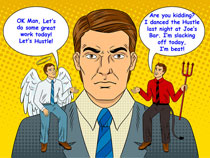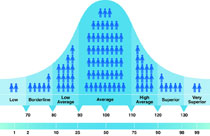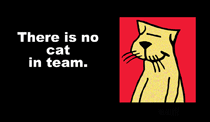 In the January/February issue of HR Magazine, Josh Bersin with Deloitte, makes nine predictions of “what’s in store for HR in 2015.” This is part one of a series of articles looking at each of these predictions.
In the January/February issue of HR Magazine, Josh Bersin with Deloitte, makes nine predictions of “what’s in store for HR in 2015.” This is part one of a series of articles looking at each of these predictions.
The second prediction in this series is that performance management will be redefined - again, thus the title "Play it Again Sam." Over the decades, performance management has endured or enjoyed, depending on your point of view, changes that have affected the workforce in no small measure.
In 1911 Frederick Taylor came up with the concept of scientific management. This concept came out of his observations of inefficiencies in the steel industry. While this method did improve productivity, the work became monotonous and boring. Where have we heard THAT sung before? Charges arose that work had become dehumanizing and this led to investigations by Congress - no small measure indeed.
 When front line high performers receive recognition for their good work, it is frequently given through receiving a promotion to management as a first line supervisor. The premise is, of course, that because they are high performers, they are well equipped to handle the next step in a career. It is also true that when these high performers receive these promotions, failure is all too often the result. Why is this?
When front line high performers receive recognition for their good work, it is frequently given through receiving a promotion to management as a first line supervisor. The premise is, of course, that because they are high performers, they are well equipped to handle the next step in a career. It is also true that when these high performers receive these promotions, failure is all too often the result. Why is this?
 Numbers and I have never been real friends. This is especially true if I must add, subtract, divide, multiply, take their square root, or label geometric shapes with them. My head is spinning already! However, now numbers in the form of big data and analytics are all the rage. Are these the latest business buzz words or is there any real substance to data?
Numbers and I have never been real friends. This is especially true if I must add, subtract, divide, multiply, take their square root, or label geometric shapes with them. My head is spinning already! However, now numbers in the form of big data and analytics are all the rage. Are these the latest business buzz words or is there any real substance to data?
Data is an important measurement tool. Analyzing that data is where the real power comes in. We all know from statistics class that groups can manipulate data to support their own agendas. Errors in collecting data, prevent achieving true measurements – regardless of how much analyzing you do. The point is that the data must be reliable, and collecting it must be accurate, and consistent. Managing data efficiently and accurately is also essential to the process and the results. The next big question is, how can data help in measuring the human aspect of business, giving organizations a competitive edge, find solutions to strategic challenges, be more productive, and profitable? A tall order indeed. Here is how human analytics can help in several areas.
 The inconsistent performer on your team is one of the most difficult management challenges managers, especially new managers, face. It’s like flipping a coin, you never know if a good day or bad day will be the performance de jour for this employee. This blog looks at how to recognize performance signs, causes of poor performance, and some solutions.
The inconsistent performer on your team is one of the most difficult management challenges managers, especially new managers, face. It’s like flipping a coin, you never know if a good day or bad day will be the performance de jour for this employee. This blog looks at how to recognize performance signs, causes of poor performance, and some solutions.
How to Recognize Inconsistent Performance: The most obvious way is to recognize performance patterns. Everyone at every level in any organization has a bad day occasionally. You can use your top performers as benchmarks to understand performance patterns. For example, observe the number of days of good performance and how consistently these top performers produce quality projects. At the other end of the spectrum, here are some items to observe in an inconsistent performer:
 After writing about high potentials in the nine part “Play it Again, Sam” series and having a coaching client who is taking a hard look at identifying high potentials in her organization, I wanted to explore this topic a bit further.
After writing about high potentials in the nine part “Play it Again, Sam” series and having a coaching client who is taking a hard look at identifying high potentials in her organization, I wanted to explore this topic a bit further.
The Difference Between a High Performer and a High potential
A classic error many organizations make is promoting their top sales person to be the sales manager. More often than not, this ends in disaster. Just because someone can sell, doesn’t mean he or she can manage others or the sales process for that matter. The sales rep was a high performer, not a high potential. Now you promote the person who should have been promoted and he or she may feel like the second choice or the individual may have already quit for being passed over. It can be difficult to zero in on high potentials. More about that later. Michael Wilk with Profile International suggests 10 questions to ask in ferreting out a high potential.
 It’s no secret that training is the first on the chopping block in organizations when times get tough. Many trainers lament the fact that they get no respect. Regrettably, there is often good reason for these opinions.
It’s no secret that training is the first on the chopping block in organizations when times get tough. Many trainers lament the fact that they get no respect. Regrettably, there is often good reason for these opinions.
According to a 2015 study by Training, Organizations spend around $70 Billion on training. Many times this hefty price tag comes with no ROI. CEOs are pulling their hair out over the failure of training programs. This includes both inside and outside training programs. A typical example is communication.
Upon a few communication failures such as information being withheld, unnecessary communication, not enough communication, inappropriate communication, the wrong communication, etc., etc., etc. someone in management calls for communication training, Dutifully, the in-house trainer slaps together a communication training and everyone is required to attend, they also must sign off that they’ve been, and there may even be penalties if one does not attend. Of course, managers are exempt from attending. Everyone attends and six-weeks later, there are more communication fiascos. Sound familiar? What can be done to stop such training wrecks? Keeping with our communication example…
 Losing weight and managing have a lot in common. Both losing weight and managing people are difficult. If you’re overweight, you may often receive negative feedback about how your weight is affecting your health from family, friends, and your doctor. One of the most difficult tasks in managing people is giving negative feedback or terminating them. It just so happens that employees with bad attitudes, low performers, and the good days/bad days employees are weighing you and your department down just as excess body weight slows your body down.
Losing weight and managing have a lot in common. Both losing weight and managing people are difficult. If you’re overweight, you may often receive negative feedback about how your weight is affecting your health from family, friends, and your doctor. One of the most difficult tasks in managing people is giving negative feedback or terminating them. It just so happens that employees with bad attitudes, low performers, and the good days/bad days employees are weighing you and your department down just as excess body weight slows your body down.
Of course, the idea is to always try and keep employees by finding a way for them to add value. The employee might be able to contribute by performing different tasks on your team. They may be a better fit for another team in the same area, or they might be able to move to a different area of expertise, or location. On the other hand, allowing a poor performer, or a person with a bad attitude, or an employee who engages in unethical behavior to remain on your team is like carrying around 600 pounds of excessive baggage. However, if you feel the employee is salvageable, to ensure both yourself and the employee that you have made every effort to give them a fair chance, a good idea is to create a performance improvement plan (PIP).
 Consistency is a good thing. “Leadership paradoxes” prevent consistency. This is according to a white paper by I/O At Work . This white paper entitled “Leadership Research Trends & Insights” is chock full of interesting ideas and the latest research on leadership. In fact, some of it might make your head spin. I didn’t think that “paradoxes” is a word, but indeed it is. I visited a website about paradoxes by Encyclopedia Britannica and it just gave me a headache. Trying to lead during a paradox situation at work will no doubt give you a headache as well.
Consistency is a good thing. “Leadership paradoxes” prevent consistency. This is according to a white paper by I/O At Work . This white paper entitled “Leadership Research Trends & Insights” is chock full of interesting ideas and the latest research on leadership. In fact, some of it might make your head spin. I didn’t think that “paradoxes” is a word, but indeed it is. I visited a website about paradoxes by Encyclopedia Britannica and it just gave me a headache. Trying to lead during a paradox situation at work will no doubt give you a headache as well.
The white paper offers that leaders who can engage in big picture thinking seem to fare better during paradoxical times. This has to do with the ability to see different perspectives. In other words, the paper goes on, clinging to one philosophy or perspective if you will, just for the sake of chasing consistency never works.
 Once I had a boss who said there are three types of employees, the work horses, the non-consistent employee (these are the ones who on any given day, may perform well one day and poorly the next – it’s a toss of the coin), and finally there are the dead wood employees.
Once I had a boss who said there are three types of employees, the work horses, the non-consistent employee (these are the ones who on any given day, may perform well one day and poorly the next – it’s a toss of the coin), and finally there are the dead wood employees.
As you can see from the bell curve, high-performing employees are to the right of center and low performers are to the left of center. Average performers are in the middle. New hires would be designated as average as they typically take more of the manager’s time and energy. We know that our energy is a valuable resource. Therefore, the question to ask is: “Where do managers typically spend their time and energy?” We should be focusing our energy where it can produce
the greatest value. Coaching average to low performing employees is not the place to expend such a valuable resource. Spending energy coaching the top 40% to 50% provides the greatest return. For average performing employees, mentoring, guiding, and some coaching is the way to go. Poor or low performers need supervising. Further, coaching the top performers elicits three valuable ROIs:
 There are several reasons to evaluate the validity and ROI of a coaching program.
There are several reasons to evaluate the validity and ROI of a coaching program.
- Fiscal responsibility. Coaching comes at a price of not only money, but time and energy. All have a cost to the bottom line.
- Coming off a tight economy that has not fully recovered. Therefore closer scrutiny and tougher decisions are in order.
- Since, as this paper mentions, coaching is still beset with doubters, it is essential to prove the effectiveness of coaching to the bottom line.
- It is imperative to distinguish effective from non-effective coaching
Bearing these essentials in mind, there are many variables and items to measure and these variables are not always numeric. In addition, many coaching experts suggest that only about 5% of coaching programs should be measured in terms of ROI. Further, no two coaching assignments are the same and no two coaches approach coaching from the same perspective. Nevertheless, it is important to review effectiveness and quantify impact of coaching. Ways to help measure coaching consist of evaluating some of the following:
 Does your team work together? No, I don’t mean do they cooperate, collaborate, and have a culture of kumbayah. Do they physically work together every day? This is an important question to ask as it can change the way you manage, save you time, and resources.
Does your team work together? No, I don’t mean do they cooperate, collaborate, and have a culture of kumbayah. Do they physically work together every day? This is an important question to ask as it can change the way you manage, save you time, and resources.
Recently, I had the opportunity to deliver a program to a group of mid-level executives, each in a different city and in charge of a different market sector for their organization. The manager, a VP in the organization was intent on teambuilding and that had been his management focus. However, during the program, one of the participants stated aloud that he found no benefit in their weekly teambuilding phone calls. Ouch!
The executive and I looked at his team and he realized that that they don’t work together or even depend on one another for resources or business. While that is true, I pointed out to the manager that the concentration should be on having his team focus on the strategic plan, ensure that each of his managers buys into the vision for the organization, and then drive that vision throughout their own teams. But don’t they still need to collaborate and cooperate? Glad you asked.

Since I do coaching, this topic is of immense interest to me and how I serve my clients. But it should be of interest to every executive and manager who seeks to achieve goals, improve performance, build relationships, and excel at leadership.
Don’t get the idea that I’m going to tell you that coaching is the silver bullet you need to solve all your problems as well as the problems of your executive team and managerial staff. Unfortunately, the Lone Ranger was the only one with silver bullets. Sorry, Kemosabe. However, because coaching is a relatively new tool in the scheme of things, research on its effectiveness has been at best sketchy and some of it downright bad. Of course, every study has its flaws and recommendations for the next study team to do things differently, better, bigger, or in more detail. The information for this blog post is drawn from three studies, listed at the end of this article along with apologies to AMA rules and guidelines.
 In the January/February issue of HR Magazine, Josh Bersin with Deloitte, makes nine predictions of “what’s in store for HR in 2015.” This is part nine of a series of nine articles looking at each of these predictions.
In the January/February issue of HR Magazine, Josh Bersin with Deloitte, makes nine predictions of “what’s in store for HR in 2015.” This is part nine of a series of nine articles looking at each of these predictions.
Mr. Bersin’s article on professional development concentrates on HR. His suggestions are
- Reduce the number of HR generalists and replace them with HR business partners
- Change the focus from “centers of expertise” to “networks of expertise”
- Concentrate hiring and training on the new competencies of high impact HR teams
The article goes on to briefly discuss how HR needs to become more of a business partner. The way to achieve this is to become “bold, innovative, and forward-thinking.” Where have we heard THAT tune before? At any rate, Mr. Bersin was not suggesting that development be restricted to HR. In order for development to be effective, it must be embedded in an organization’s DNA. Trends or predictions, affect the entire organization, not just one department.
The American Management Association has 10 predictions of its own about development.

Bogino Executive Coaching, Bogino Assessments, Bogino DISC Certification, Bogino Team building, Bogino Training, Bogino Speaking
First Things First: How do you build leaders for the future? First realize that middle managers do have the capacity and are in the position to be leaders. Now, provide the training, the coaching, and mentoring they need to carry them through to their next step on the organizational ladder. IN short, middle managers need role models. Performing these vital tasks lays a solid foundation for the future.
 In the January/February issue of HR Magazine, Josh Bersin with Deloitte, makes nine predictions of “what’s in store for HR in 2015.” This is part one of a series of articles looking at each of these predictions.
In the January/February issue of HR Magazine, Josh Bersin with Deloitte, makes nine predictions of “what’s in store for HR in 2015.” This is part one of a series of articles looking at each of these predictions. When front line high performers receive recognition for their good work, it is frequently given through receiving a promotion to management as a first line supervisor. The premise is, of course, that because they are high performers, they are well equipped to handle the next step in a career. It is also true that when these high performers receive these promotions, failure is all too often the result. Why is this?
When front line high performers receive recognition for their good work, it is frequently given through receiving a promotion to management as a first line supervisor. The premise is, of course, that because they are high performers, they are well equipped to handle the next step in a career. It is also true that when these high performers receive these promotions, failure is all too often the result. Why is this? Numbers and I have never been real friends. This is especially true if I must add, subtract, divide, multiply, take their square root, or label geometric shapes with them. My head is spinning already! However, now numbers in the form of big data and analytics are all the rage. Are these the latest business buzz words or is there any real substance to data?
Numbers and I have never been real friends. This is especially true if I must add, subtract, divide, multiply, take their square root, or label geometric shapes with them. My head is spinning already! However, now numbers in the form of big data and analytics are all the rage. Are these the latest business buzz words or is there any real substance to data? The inconsistent performer on your team is one of the most difficult management challenges managers, especially new managers, face. It’s like flipping a coin, you never know if a good day or bad day will be the performance de jour for this employee. This blog looks at how to recognize performance signs, causes of poor performance, and some solutions.
The inconsistent performer on your team is one of the most difficult management challenges managers, especially new managers, face. It’s like flipping a coin, you never know if a good day or bad day will be the performance de jour for this employee. This blog looks at how to recognize performance signs, causes of poor performance, and some solutions. After writing about high potentials in the nine part “Play it Again, Sam” series and having a coaching client who is taking a hard look at identifying high potentials in her organization, I wanted to explore this topic a bit further.
After writing about high potentials in the nine part “Play it Again, Sam” series and having a coaching client who is taking a hard look at identifying high potentials in her organization, I wanted to explore this topic a bit further. It’s no secret that training is the first on the chopping block in organizations when times get tough. Many trainers lament the fact that they get no respect. Regrettably, there is often good reason for these opinions.
It’s no secret that training is the first on the chopping block in organizations when times get tough. Many trainers lament the fact that they get no respect. Regrettably, there is often good reason for these opinions. Losing weight and managing have a lot in common. Both losing weight and managing people are difficult. If you’re overweight, you may often receive negative feedback about how your weight is affecting your health from family, friends, and your doctor. One of the most difficult tasks in managing people is giving negative feedback or terminating them. It just so happens that employees with bad attitudes, low performers, and the good days/bad days employees are weighing you and your department down just as excess body weight slows your body down.
Losing weight and managing have a lot in common. Both losing weight and managing people are difficult. If you’re overweight, you may often receive negative feedback about how your weight is affecting your health from family, friends, and your doctor. One of the most difficult tasks in managing people is giving negative feedback or terminating them. It just so happens that employees with bad attitudes, low performers, and the good days/bad days employees are weighing you and your department down just as excess body weight slows your body down.  Consistency is a good thing. “Leadership paradoxes” prevent consistency. This is according to a white paper by
Consistency is a good thing. “Leadership paradoxes” prevent consistency. This is according to a white paper by  Once I had a boss who said there are three types of employees, the work horses, the non-consistent employee (these are the ones who on any given day, may perform well one day and poorly the next – it’s a toss of the coin), and finally there are the dead wood employees.
Once I had a boss who said there are three types of employees, the work horses, the non-consistent employee (these are the ones who on any given day, may perform well one day and poorly the next – it’s a toss of the coin), and finally there are the dead wood employees. There are several reasons to evaluate the validity and ROI of a coaching program.
There are several reasons to evaluate the validity and ROI of a coaching program. Does your team work together? No, I don’t mean do they cooperate, collaborate, and have a culture of kumbayah. Do they physically work together every day? This is an important question to ask as it can change the way you manage, save you time, and resources.
Does your team work together? No, I don’t mean do they cooperate, collaborate, and have a culture of kumbayah. Do they physically work together every day? This is an important question to ask as it can change the way you manage, save you time, and resources.
 In the January/February issue of HR Magazine, Josh Bersin with Deloitte, makes nine predictions of “what’s in store for HR in 2015.” This is part nine of a series of nine articles looking at each of these predictions.
In the January/February issue of HR Magazine, Josh Bersin with Deloitte, makes nine predictions of “what’s in store for HR in 2015.” This is part nine of a series of nine articles looking at each of these predictions.